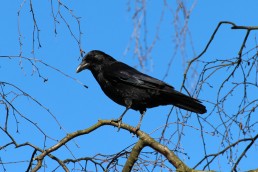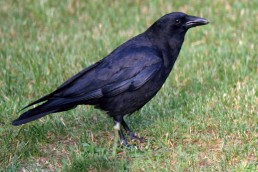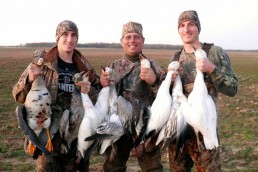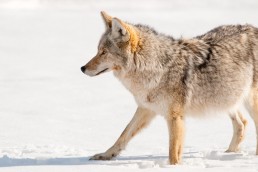Extend Wingshooting Season by Challenging Crows
SHARE THIS POST
When hunting seasons end in late fall many clean their guns and put them away. And many states have waterfowl seasons that are split, leaving waterfowlers a gap where they have nothing to hunt—at least nothing on the wing to keep their shooting skills sharp. Often, though, these same states have crow seasons that could fill the gap between regular hunting seasons.
If you’ve never tried gunning for crows, you’re missing out on some fast wingshooting.
Most of my life I’ve lived near a large crow roost, with literally thousands of crows coming and going each day. Crows have flyways they follow every morning as they spread out in search of food and then return in late afternoon. All you need to do is locate a good ambush point where they pass, stop to feed or rest on their route, and set up your blind.
If you are going to hunt crows in their feeding area, you may want to use decoys. You won’t need many; six to 12 is usually enough. However, you do need to place them so they can be seen for some distance.
A good place to put a blind is on a corner of a woodlot jutting out into a feeding field. When crows fly to fields to feed, they usually have a sentry watching in a nearby tree. Of course, if you arrive before they do, you can avoid this if you get there before daylight to set up your blind.
Place the decoys on the ground fairly far apart—maybe 10 feet or so—and facing in different directions as they would be if they were searching for food. Some like to put a decoy in a tree that’s close, but I never do because I can’t get it as high as a real sentry, and I want things to look natural.
Unless you are very good with a crow call, it is best not to use one. I advise practicing on passing crows that show no interest in stopping. If some are coming to the decoys, don’t blow the call. Crows have a distress call and an alarm call, just to mention a few, and the wrong note can cause them to fly in the opposite direction. Three loud sharp notes is their “danger” signal and they will fly as fast as they can to get away.
If you own an electric game caller, use one of the professionally recorded tapes or CD recordings. In the right location, crows will flock to see what is causing these loud, aggressive sounds.
Are you enjoying this post?
You can be among the first to get the latest info on where to go, what to use and how to use it!
Crows hate owls because owls prey on them at night while they are roosting. Therefore, any time a crow spots an owl, it will “scream and yell,” and soon other crows will be on the scene to join in on the fun. Years ago—when owls were not protected—some crow hunters actually used live owls as decoys. A decoy owl sitting in the open where the crows can see it works especially well with an electronic caller. If you don’t have a crow call or decoys, you still can enjoy crow hunting. I have killed more crows without calls or decoys than with them.
If there are large woods along their morning or afternoon flyway, you can easily hide in the trees and shoot as the crows pass over. After the first shot crows nearby will scatter, but others far down the flyway will soon arrive. If you have ever shot at crows en route on a flyway, you may have noticed how the ones behind the bird you shot at flared off to the side, and then every crow behind avoided that spot when they flew toward it.
Eventually, one will fly over again, and the ones behind will follow, giving you another chance. Just make sure they can’t see you in the blind or behind a tree. Crows have exceptionally keen eyesight and can detect any movement. Use a small peephole if you are in a blind, and rise up to shoot at the last second.
When crows are at rest in the woods and you can hear them at a distance, it is best not to get too close. Find a spot they are likely to fly over on their way back to the roost and make your setup there. This is a good time to work on your crow-calling skills. One long “ascending” note followed by two or three “weaker descending” notes is a “dying crow.” They will often come to investigate what has caught one of their companions. Even if you are unsuccessful at calling the crows closer, they will act as decoys for crows on their way back to roost, giving you chances at passing birds.
If you don’t live near a large roost, you can still bag local birds. Many smaller flocks stay the winter. It may be harder to hunt these, and you may get fewer shots, but you still should get some shooting opportunities.
I use my duck and goose gun for crows. Although I’ve been out hunting for woodcock, and have shot crows with light loads from a short-barreled 20 gauge, I prefer a full or modified choke so I can shoot at the crows that are passing high or making a hasty retreat. Remember you can always let a bird get farther out before you shoot, but you can’t always make one come closer.
Crows are tough birds, and sometimes it can take a lot to bring them down. They are not large birds, however, so you need enough pellets in the pattern to hit a vital area. In a 12 gauge, 1 1/8 ounces of number 6 shot is best. I have also enjoyed real good results with a heavy field load of 1 1/4 ounces of number 4 shot that I reloaded myself. If you use small shot like number 7 1/2, keep the shots inside 40 to 45 yards.
As I sit here writing, I can hear the call of a crow in a tree over a cornfield behind my house. And I can hear another answering in the distance. Crows can be challenging to hunt, and they have given me many enjoyable hours in the field and have made me a better wing shot. I hope this information is helpful to you should you decide to try crows and fill the gap between seasons.
MWO
SHARE THIS POST
Did you enjoy this post?
You can be among the first to get the latest info on where to go, what to use and how to use it!
Ken Barnes
Kenneth Edward Barnes has more than 80 paperback and e-books listed on Amazon in several genres. His most popular include: The Mammoth Slayers, Mysteries of the Bible and A Cabin in the Woods. In addition to many others, he also has two outdoor books, Barnestorming the Outdoors and Outdoor Adventures.



